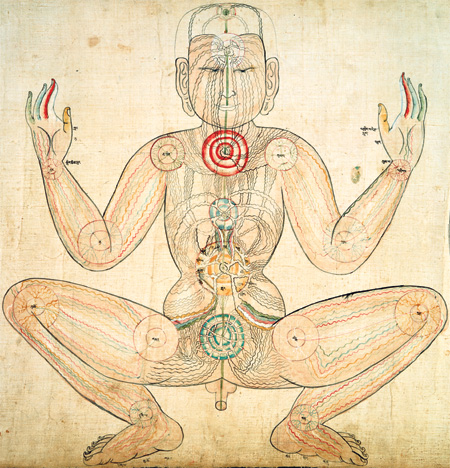
|
| The first image depicting the channels and centres |
Inner Kālacakra
The channels and centres, part 1
Previous Page – Next Page
The final pair of paintings in this set depict inner Kālacakra: the body together with its channels and centres. Some of the main winds are also described here. The original material for this in the second chapter of the Vimalaprabhā has been reliably translated by Vesna Wallace, under the title: "The Kālacakratantra. The Chapter on the Individual together with the Vimalaprabhā". Where relevant in the following, references will given to verse numbers (eg. v.25.) in the second chapter as given in Vesna Wallace's text. Also see section 9, on "Channels, Winds and Drops", in the "Ornament of Stainless Light", by Norzang Gyatso, translated by Gavin Kilty.The channels and centres are here represented as they are considered to exist within the body. In another sense, they are also imagined in meditation practices, but in that case their forms are more stylised, more regular, with the main channels straight, and so forth. In the form in which they are shown here, a great number are considered (a total of 72,000), and they are naturally depicted in a more organic form. Branching off from the vertical central channel are six centres ('khor lo, cakra) of minor channels. These are associated with the various elements (v.25.), and have different numbers of minor channels, or channel-petals (rtsa 'dab). They also have colours associated with them, depending on the element:
Crown – space – green – 4
Forehead – water – white – (4) – 8 – 16
Throat – fire – red – (4) – 8 – 32
Heart – wind – black – 4 – 8
Navel – earth – yellow – 4 – 8 – 12/16 – 64
Genitals – awareness – blue – 6 – 10 – 16
The sets of numbers above represent the branching of the channel-petals. For example, at the genital centre (v.46.), six channels branch from the central channel. Four of these each split into two, making a total of ten intermediate channel-petals. Finally, of these ten, six split into two, making a total of 16 outer channel-petals. A similar description applies to the other centres here. In the painting, however, the channels of the genital centre do not quite fit this description, although the other centres do match the expected numbers. For two of the centres in the list above, the number 4 is in brackets. This is because in some descriptions they are both given as having eight channel-petals branching off from the central channel.
In addition to these main centres, this painting also depicts the twelve centres in the main joints (shoulders, elbows, wrists, hips, knees and ankles) and the minor centres in the knuckles of the fingers and toes. These all constitute the indestructible aspect of the body (rdo rje'i lus, vajrakāya). In the preliminary parts of the main meditations of Kālacakra, seed syllables (also given in v.68.) are imagined at the various channels of these centres.
The centres of the three joints of the left leg are associated with the element of earth, those of the right leg with water, those of the left arm fire and those of the right arm, wind. Each of the fingers and toes consist of three knuckles each, with each one having its own minor centre. The thumb and big toe (v.26.) are associated with the element of earth, the first finger and first toe, water, then fire, wind (there is a mistake here in Wallace's text) and space for the little fingers and toes. The three rows of knuckles are each associated with one of the three qualities (yon tan, guṇa): sattva, rajas and tamas.
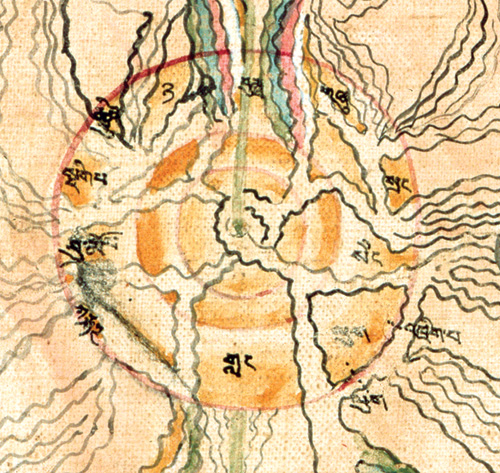
|
| The navel centre |
The centres are those places where channels are grouped together, and are where the winds are active and changes take place in the movements of those winds. These changes are considered to take place at regular intervals, and these are correlated in various ways with changes in the external physical world. In a general sense, winds are considered to move in one channel for a particular period of time, and then change to another channel. The most important of the external changes lies in the rising of the different signs of the zodiac. The sign coming over the horizon in the east is known as the ascendant (dus sbyor, lagna), although the association is also made with the passage of the Sun through the various signs.
In the image on the left, the navel centre is shown. The 12 intermediate channel-petals are associated here with the 12 ascendants. Starting at the front (in the bottom of this image) the first channel to the left (-side of the body, therefore to the right in this image) is Aries. The first to the right is Taurus. The word for Taurus (glang) is visible right in the middle of the lower part of the image. We then progress around from these: the next to the left is Gemini, and the next to the right is Cancer, and so forth. The signs Taurus, Cancer, and so forth on the right are called the even signs, and Aries, Gemini, etc., are the odd signs (v.40.).
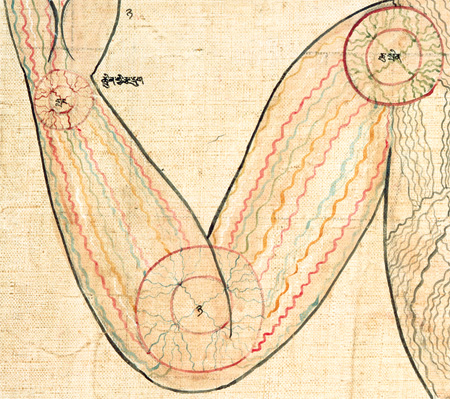
|
| The joints of the right arm |
In the image on the right are seen the major joints of the right arm. The shoulder is associated with Capricorn (v.67, 68.), the elbow with Pisces and the wrist with Taurus. The Vimalaprabhā lists these a little differently. For example, the right elbow is associated with the month of Caitra (nag pa); this is the month during which the Sun leaves the sign of Pisces and enters Aries. These associations are given in the next painting.
The equivalent joints of the left arm are associated with Aquarius, Aries and Gemini. Notice that the channels following the length of the arm are of different colours, indicating their association with the different elements.
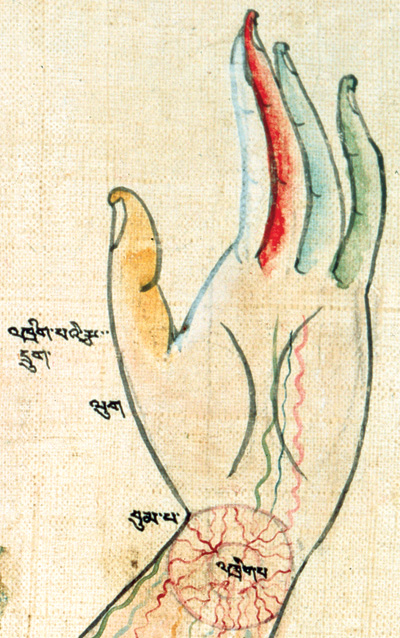
|
| The left hand |
The image on the left shows the left hand, and the writing indicates the signs associated with the three different rows of knuckles. These are the same signs as are associated with the main joints of the left arm: the first (inner) row of knuckles with Aquarius, the middle row with Aries and the outer row with Gemini.
The equivalent associations for the right hand are Capricorn, Pisces and Taurus.
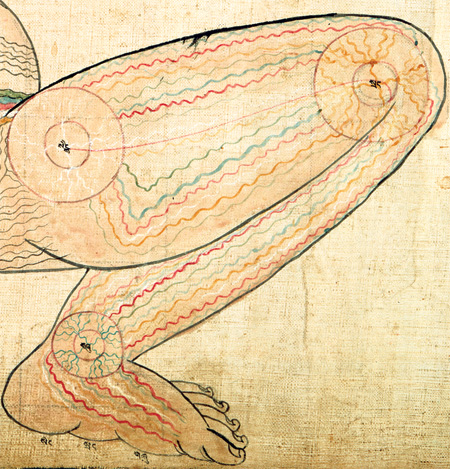
|
| The joints of the left leg |
In the image on the right are shown the centres of the left leg. The hip is associated with Leo, the knee with Libra and the ankle with Sagitarrius. The writing at the bottom associates these same signs with the rows of toe knuckles of the left foot. The equivalent joints of the right leg and toes are associated respectively with Cancer, Virgo and Scorpio.
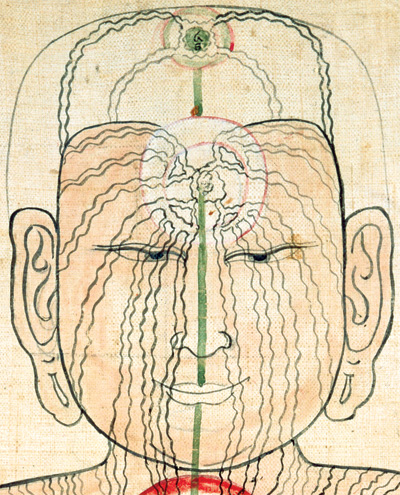
|
| The channels of the head |
The image on the left shows the head. The forehead centre is clearly visible with its 16 channel-petals (only 14 are drawn here). Above is the crown centre with four channels, in the middle of which can be seen an upside-down syllable "haṃ", representing the white element, or bodhicitta (byang sems).
Previous Page – Next Page
Last updated 2 March 2010.
E. Henning.
Return to Home Page.